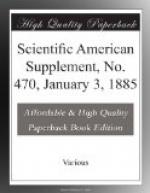In closing his paper Dr. Mott said that he would risk the fallacy of the current theory of sound on the argument advanced relating to the impossibility of the slow motion of a tuning fork to produce sonorous waves, and stated that he would retire if any one could show the fallacy of the argument; but if not, the wave theory must be abandoned as absurd and fallacious, as was the Ptolemaic system of astronomy, which was handed down from age to age until Copernicus and his aide de camp Galileo gave to the world a better system.
* * * * *
THE ATTOCK BRIDGE.
We give illustrations from Engineering of a bridge recently constructed across the Indus River at Attock, for the Punjaub Northern State Railway. This bridge, which was opened on May 24, 1883, was erected under the direction of Mr. F.L. O’Callaghan, engineer in chief, Mr. H. Johnson acting as executive engineer, and Messrs. R.W. Egerton and H. Savary as assistants.
[Illustration: BRIDGE OVER THE RIVER INDUS AT ATTOCK: PUNJAUB NORTHERN STATE RAILWAY, INDIA.]
The principal spans cover a length of about 1,150 feet. It will be seen from the diagram that there is a difference of nearly 100 feet in the levels of high and low water.
* * * * *
THE ELASTICITY OF METALS.
M. Tresca has contributed to the Comptes Rendus some observations on the effect of hammering, and the variation of the limit of elasticity of metals and materials used in the arts.
He says that hitherto, in considering the deformation of solids under strain, two distinct periods, relative to their mechanical properties, have alone been recognized. These periods are of course the elastic limit and the breaking point. In the course of M. Tresca’s own experiments, however, he has found it necessary to consider, at the end of the period of alteration of elasticity, a third state, geometrically defined and describable as a period of fluidity, corresponding to the possibility of a continuous deformation under the constant action of the same strain. This particular condition is only realized with very malleable or plastic bodies; and it may even be regarded as characteristic of such bodies, since its absence is noticeable in all non-malleable or fragile bodies, which break without being deformed. It is already known that the period of altered elasticity for hard




